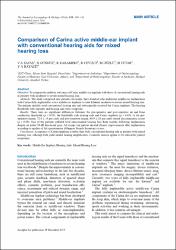| dc.contributor.author | Savaş, Veysel | |
| dc.contributor.author | Gündüz, Bülent | |
| dc.contributor.author | Karamert, Recep | |
| dc.contributor.author | Cevizci, Raşit | |
| dc.contributor.author | Düzlü, Mehmet | |
| dc.contributor.author | Tutar, Hakan | |
| dc.contributor.author | Bayazit, Yıldırım Ahmet | |
| dc.date.accessioned | 10.07.201910:49:13 | |
| dc.date.accessioned | 2019-07-10T19:58:29Z | |
| dc.date.available | 10.07.201910:49:13 | |
| dc.date.available | 2019-07-10T19:58:29Z | |
| dc.date.issued | 2016 | en_US |
| dc.identifier.citation | Savaş, V., Gündüz, B., Karamert, R., Cevizci, R., Düzlü, M., Tutar, H. ... Bayazit, Y. A. (2016). Comparison of carina active middle-ear implant with conventional hearing aids for mixed hearing loss. Journal Of Laryngology And Otology, 130(4), 340-343. https://dx.doi.org/10.1017/S0022215116000748 | en_US |
| dc.identifier.issn | 0022-2151 | |
| dc.identifier.issn | 1748-5460 | |
| dc.identifier.uri | https://dx.doi.org/10.1017/S0022215116000748 | |
| dc.identifier.uri | https://hdl.handle.net/20.500.12511/3178 | |
| dc.description | WOS: 000373127800005 | en_US |
| dc.description | PubMed ID: 26991874 | en_US |
| dc.description.abstract | Objective: To compare the auditory outcomes of Carina middle-ear implants with those of conventional hearing aids in patients with moderate-to-severe mixed hearing loss. Methods: The study comprised nine patients (six males, three females) who underwent middle-ear implantation with Carina fully implantable active middle-ear implants to treat bilateral moderate-to-severe mixed hearing loss. The patients initially used conventional hearing aids and subsequently received the Carina implants. The hearing thresholds with implants and hearing aids were compared. Results: There were no significant differences between: the pre-operative and post-operative air and bone conduction thresholds (p > 0.05), the thresholds with hearing aids and Carina implants (p > 0.05), or the pre-operative (mean, 72.8 +/- 19 per cent) and post-operative (mean, 69.9 +/- 24 per cent) speech discrimination scores (p > 0.05). One of the patients suffered total sensorineural hearing loss three months following implantation despite an initial 38 dB functional gain. All except one patient showed clinical improvements after implantation according to quality of life questionnaire (Glasgow Benefit Inventory) scores. Conclusion: Acceptance of Carina implants is better than with conventional hearing aids in patients with mixed hearing loss, although both yield similar hearing amplification. Cosmetic reasons appear to be critical for patient acceptance. | en_US |
| dc.language.iso | eng | en_US |
| dc.publisher | Cambridge Univ Press | en_US |
| dc.rights | info:eu-repo/semantics/openAccess | en_US |
| dc.subject | Middle Ear Implant | en_US |
| dc.subject | Hearing Aids | en_US |
| dc.subject | Mixed Hearing Loss | en_US |
| dc.title | Comparison of Carina active middle-ear implant with conventional hearing aids for mixed hearing loss | en_US |
| dc.type | article | en_US |
| dc.relation.ispartof | Journal Of Laryngology And Otology | en_US |
| dc.department | İstanbul Medipol Üniversitesi, Tıp Fakültesi, Cerrahi Tıp Bilimleri Bölümü, Kulak Burun Boğaz Hastalıkları Ana Bilim Dalı | en_US |
| dc.authorid | 0000-0002-3887-4569 | en_US |
| dc.identifier.volume | 130 | en_US |
| dc.identifier.issue | 4 | en_US |
| dc.identifier.startpage | 340 | en_US |
| dc.identifier.endpage | 343 | en_US |
| dc.relation.publicationcategory | Makale - Uluslararası Hakemli Dergi - Kurum Öğretim Elemanı | en_US |
| dc.identifier.doi | 10.1017/S0022215116000748 | en_US |
| dc.identifier.wosquality | Q4 | en_US |
| dc.identifier.scopusquality | Q2 | en_US |


















